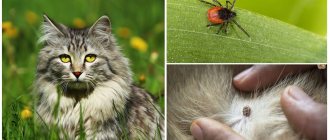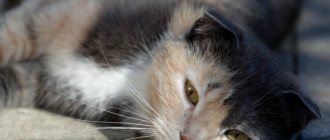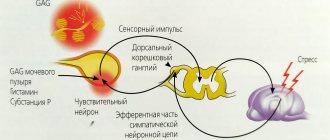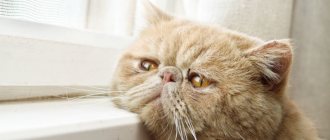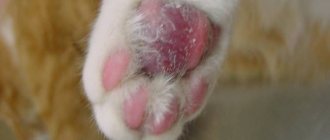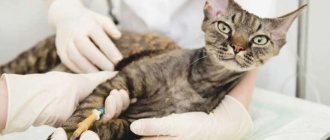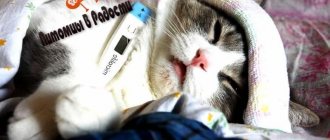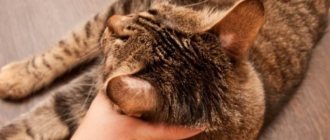9770Pavel
Despite the increased cleanliness of cats, they are not immune from various diseases, including the most dangerous ones, which can cost them their lives if incorrectly diagnosed and treated. One of these diseases is panleukopenia or feline distemper, another name for viral enteritis. Every owner of a furry pet should know the symptoms and treatment of panleukopenia in cats, only this will save the cat from unnecessary suffering and torment. Timely prevention of the disease is better than treatment.
Distemper: what is the disease?
Panleukopenia is an infectious viral disease, which, as mentioned above, develops when the feline panleukopenia virus enters the body. After infection, the number of lymphocyte cells in a pet decreases, and damage occurs to the intestinal walls and lymphatic system.
In most cases, the virus affects kittens and older animals due to a weak immune system. The period when the virus is rampant is spring and summer, when animals reproduce.
Since viral enteritis often causes death, if symptoms of panleukopenia are detected in a cat, treatment should be started immediately by contacting a veterinary clinic.
Disease prevention
To prevent the spread of plague:
- Isolation of an infected cat from healthy individuals.
- Timely vaccination against panleukopenia. Vaccination is indicative for two-month-old kittens. Modern vaccines against infectious gastroenteritis also protect against rhinotracheitis and calcivirosis. Only a veterinarian has the right to vaccinate animals.
It is unacceptable to vaccinate individuals with weakened immune systems, as this may cause distemper infection.
Routes of transmission of the virus
The source of this dangerous disease is sick animals or animal carriers. Parvovirus is released into the external environment along with saliva and feces. How is panleukopenia transmitted? Infection can occur in the following ways:
- Oral. The virus will enter the animal's mouth if it drinks water or eats food from the bowl of a sick cat.
- By airborne droplets. Infection occurs if a healthy cat is in close proximity to a sick one.
- By contact. An animal can become infected if it sniffs the personal belongings of an owner who has been in contact with a sick animal or if there is direct contact with a virus carrier.
- In utero. There are no barriers to distemper parvovirus. In addition, it penetrates the placenta. If infection occurs at an early stage, the kittens die in the womb or after birth. If this happened when they were fully formed, then the babies will be born with an underdeveloped cerebellum.
- Transmissible. Such infection is possible through the bite of fleas, bedbugs and ticks.
Almost all members of the cat family can become infected with the virus. It is not as common in wild animals as in domestic animals. Often the disease affects unvaccinated animals before one year or after eight years.
Pregnant cats and small kittens are at risk. Persians, Siamese and Maine Coons have a natural predisposition to the disease.
"Important! Owners of sick animals should not worry; feline panleukopenia is not dangerous to humans.”
Incubation period: duration and features
As a rule, the incubation period (more precisely, its duration) depends on a combination of several factors:
- From the method of infection. Thus, after direct contact with a sick animal, the incubation period rarely takes more than six days. With the fecal-oral route of infection, the first symptoms appear within seven or eight days.
- The duration of incubation largely depends on the age of the pet. So, kittens “lie down” for a couple of days at most, but young and healthy cats can show signs of the disease after 10 days, or their pathology immediately turns into a subclinical, hidden form. Old pets also get sick very quickly and their illness is very severe.
- Of course, a lot depends on the initial state of the cat’s immunity. The healthier she is, the greater the chance of a mild form of the disease. Accordingly, an exhausted and weakened animal may well become ill within 10-15 hours from the moment of contact with a sick relative, and it will be extremely seriously ill.
Finally, the average incubation period is 6 to 10 days.
Forms of disease development
Distemper in cats can develop in four forms:
- Sub-acute. This course of the disease is typical for pets with strong immunity. The incubation period lasts from one to two weeks. Symptoms in this case will be subtle, and recovery will occur faster than in animals with reduced immunity.
- Spicy. In the acute course of panleukopenia, the disease manifests itself after two days. This form is more common in adult cats.
- Lightning fast. This form is diagnosed in young cats. In kittens, it develops a few hours after pathogenic microorganisms enter the animal’s body. Clinically, this panleukopenia is similar to rabies, but it does not have time to fully develop and the animal dies.
- Chronic. Just a few years ago, veterinarians argued that distemper cannot have a chronic form. However, this theory was recently disproved by blood tests on strays and pets. In some samples, antibodies to panleukopenia parvovirus and the virus itself were detected in small quantities. The chronic course is usually asymptomatic. From time to time, the animal may experience weakness and causeless diarrhea. But if his immune system begins to weaken, the virus will quickly multiply and lead to the sudden death of the pet.
Animals with a subacute form of viral enteritis have a high chance of recovery.
Tests and diagnostic methods: how pathology is detected
If cases of panleukopenia are frequent in a particular area, an experienced veterinarian will make a diagnosis “by eye” without any problems. But this does not negate the need to conduct a comprehensive examination of a sick cat.
The clinic immediately does a general blood test: in most cases this is quite sufficient. Hematocrit with panleukopenia is impaired in the direction of a sharp decrease in the number of leukocytes. There are especially few neutrophils, and an increased ESR is often observed. If the level of leukocytes in the blood is less than 2-109, then the prognosis, unfortunately, is unfavorable. But still, a final diagnosis cannot be made without specialized tests:
- The most accurate PCR reaction is (but the technique is not cheap).
- Most often, ELISA is performed. In this case, they look for specific antibodies in the blood.
Note that in some regions, ELISA can show almost 100% positive results, and therefore you do not need to completely trust this analysis. In recent years, a situation has become very common when the blood of completely healthy cats contains antibodies to the causative agent of panleukopenia.
The first signs of plague
Typically, the virus manifests itself between the second and eighth days from the onset of the disease. If panleukopenia occurs in an acute form, then the symptoms are:
- refusal of food;
- depressed state;
- increase in body temperature up to 40 degrees;
- strong thirst, but the cat drinks very little;
- vomiting with the presence of dark yellow mucous patches;
- the appearance of dark yellow urine;
- drying out of the oral mucosa;
- blueness of the soft palate;
- the appearance of rhinitis, swelling of the larynx and conjunctivitis.
If at least a few signs that characterize distemper occur, the animal should be immediately taken to a doctor to increase its chances of recovery.
Symptoms of panleukopenia in cats
The first signs of panleukopenia in cats should alert even inexperienced owners. Having realized that something strange is happening to your pet, you need to show it to the veterinarian as soon as possible. And even if it is often difficult to make an accurate diagnosis of panleukopenia on your own, a specialist will come to the rescue, explaining what actions are required from the owner and how the cat can be helped in this situation.
© shutterstock
These symptoms indicate the presence of a disease:
- the cat becomes lethargic and apathetic, it is not interested in anything;
- body temperature changes, it rises;
- with panleukopenia, the need for food decreases, up to a complete refusal of it;
- the cat may be thirsty or, on the contrary, the animal may stop drinking liquid altogether;
- breathing becomes heavy and quickens;
- the cat may have a fever;
- sometimes the skin becomes covered with ulcers.
As already mentioned, with panleukopenia the cat’s behavior changes, and it is simply impossible to notice this. The animal tries to hide away in a corner from people and avoids communicating with other pets. Not before now. She has a fever, and her body temperature can reach 41°C, when the norm is 38°C. In some cases, the cat may vomit mucus that is yellow-green in color. Urine with panleukopenia may change color to bright orange. And since this disease affects the gastrointestinal tract, the animal often suffers from diarrhea. There may even be some blood in the stool.
Symptoms of panleukopenia
The virus first affects the small intestine, then it enters the bone marrow, lymphatic system, and so, gradually has a damaging effect on all organs in the body. Each form of the disease has its own symptoms. For fulminant distemper, which is typical for kittens up to two weeks of age, the signs are apathy, refusal to eat, plaintive meowing and deterioration in health. Even if you start treating children, in 98% of cases they will die, since the immune system is not able to overcome the disease. In older kittens, hyperacute distemper occurs in the presence of the following signs:
- lethargy;
- lack of response to stimuli;
- dull and matted fur;
- paralysis;
- convulsions;
- bloody vomiting or vomiting with bile.
In kittens from three to seven months old, when this form of the disease develops, the nervous system suffers and the same symptoms appear as with rabies. They are afraid of sounds, hide in dark corners, react aggressively to light, scream and experience nervous overexcitement. A little later, the kitten begins to have diarrhea with a foul odor mixed with blood.
The acute form is diagnosed in adult animals. Its symptoms are as follows:
- apathy;
- high temperature;
- shortness of breath;
- refusal of food;
- yellow, green, or bloody vomit;
- watery stools;
- the appearance of red spots on the skin, which fester and then disappear.
High temperatures do not last long, after which they drop to 37 degrees. A lower temperature indicates that the cat will die soon. The sick animal is thirsty, but strong spasms of the larynx prevent it from drinking. When the virus reaches the heart, shortness of breath begins and heart failure develops. When pathogenic microorganisms enter the lungs, the following symptoms appear:
- nasal discharge;
- redness of the eyes and profuse lacrimation;
- hot and dry nose;
- wheezing and coughing;
- suppuration on the skin.
The subacute form of panleukopenia is considered the most favorable. It is characterized by the main symptoms of plague, but not so pronounced. This development occurs in animals with strong immunity or in cats that have been vaccinated.
More information about the causative agent of the disease
The causative agent of a disease such as distemper in cats is a virus whose genome is represented by single-stranded DNA. It is highly stable in the environment and resistant to various chemical compounds (phenols, ether, acids). At temperatures above 50 °C it remains active for an hour.
Once in the body of a susceptible animal, the pathogen multiplies in the thymus gland and spleen, then spreads throughout the body, penetrating primarily into the rapidly dividing cells of the bone marrow, lymphoid tissue and intestines.
Diagnosis of viral enteritis
Only a veterinarian can understand whether a cat is suffering from distemper or is developing a completely different illness. To do this, you need to take the animal to the clinic, taking with you the vaccination passport and pet card. First, a specialist will examine the animal, and then tests for panleukopenia will be performed.
A sample of the animal's stool will be taken using the PRC method. This study will help find particles of a dangerous virus in it. Blood will also be drawn. If the doctor finds a decrease in the leukocyte level in the test results, then the disease is confirmed.
A similar set of differential diagnostic measures is necessary in order to really make sure that an animal has distemper, because its symptoms are similar to leukemia, immunodeficiency, poisoning and intestinal perforation. Only by drawing up a complete clinical picture can the diagnosis be confirmed or refuted.
Clinical manifestations
What are the symptoms of leukopenia in cats? Everything is quite simple here. Firstly, the animal is constantly sick. He is plagued by digestive disorders, and the cat constantly “catch” diseases of the upper respiratory tract. In severe cases, it can lead to chronic bronchitis and even pneumonia. Deterioration of the condition of the skin and coat, as well as inflammation of the gums and other periodontal diseases are often recorded. In addition, you can notice swollen and inflamed lymph nodes, the animal quickly gets tired, it is lethargic and apathetic. There is no appetite, the cat may experience constant cases of conjunctivitis, bloody diarrhea, vomiting... In short, the symptoms correspond to serious diseases of an infectious and inflammatory nature.
Let’s take a closer look at what each substance is responsible for and what to look for when interpreting tests in cats. Hematocrit (HCT)
Norm – 24-26%
Hematocrit (HCT). Norm – 24-26%
An increased number indicates a likely increase in the level of red blood cells (erythrocytosis), dehydration, the development of diabetes in the animal, and a decrease in plasma volume in the blood.
A decrease in hematocrit indicates anemia, chronic inflammation of one of the organs, cat starvation, the presence of cancer or internal infusion.
Hemoglobin (HGB). Norm – 80-150 g/l
An elevated hemoglobin level may indicate erythrocytosis or dehydration.
A reading below 80 g/l is a sign of one of several disorders, such as anemia, obvious or hidden blood loss, poisoning, or damage to the hematopoietic organs.
White blood cells (WBC). Norm – 5.5-18.0*109/l
Exceeding the norm: leukemia, development of bacterial infections or inflammatory processes, oncology.
Decreased normal: virus, bone marrow damage, damage to the body due to radioactive radiation.
Red blood cells (RGB). Norm – 5.3-10*10 12 /l
An increased level of red blood cells means the development of erythrocytosis in the body, lack of oxygen, and dehydration of the body. In some cases, it indicates kidney and liver diseases.
A low red blood cell count indicates blood loss (hidden or obvious), anemia, and the presence of chronic inflammation in the body. May appear in the last stages of pregnancy.
Treatment of plague
Clinical therapy for the disease is most effective, since it combines a full range of measures aimed at relieving the disease. It will be impossible to cure a cat at home.
How to treat panleukopenia? In each case, treatment is selected individually, taking into account the form of the disease and the general condition of the furry patient. However, there is an average therapeutic regimen that most clinics use. All of the drugs described below will need to be administered once a day:
- the drug “Forvet” is administered to the animal subcutaneously in a dose of 0.5 milliliters;
- vitamin B6 is administered intravenously in a dose of 0.5 milliliters along with the same dosage of vitamin B12;
- The cat is given 1 milliliter of Riboxin and vitamin C by intravenous infusion;
- Sinulox is administered subcutaneously at a dose of 0.2 milliliters;
- Metrogyl is administered intravenously at a dose of 2 milliliters;
- sodium chloride is dripped intravenously in a dose of 80 milliliters;
- glucose 5% is administered subcutaneously in a dose of 20 milliliters.
Antibiotics of the cephalosporin group are injected as prescribed by the veterinarian. The animal is also administered the drug “Filgrastim” to accelerate the production and release of neutrophils and other cells of the leukocyte group into the bloodstream.
Establishing diagnosis
The diagnosis of feline panleukopenia is made based on clinical signs, examination and tests. To completely exclude other pathologies and diseases, a clinical blood test is performed. Stool or urine can also be used for diagnosis. Due to the long duration of these tests, special rapid tests for panleukopenia are used to make a diagnosis.
Tests require the collection of a small amount of vomit or stool. They are placed in a special diagnostic tube with a solution. After a short shaking, the resulting solution is applied to the cassette window. Within 10-15 minutes you can evaluate the result of application. The test for the virus is considered positive if both lines are colored.
Read more about the clinical signs of panleukopenia in the Veterinary Directory.
Sick animal menu
The disease panleukopenia in cats is very difficult for animals to tolerate, and in order to maintain strength during therapy and help the pet recover faster, its diet should be carefully selected.
After the cat's appetite begins to return, it should be fed light, pureed and warm food. You shouldn’t force food on your pet when the time comes for him to eat on his own.
Portions should be small. A sick cat should be fed six times a day. From food you can give low-fat broth, yogurt, kefir and cottage cheese. After three days, in order for the cat to recover faster from panleukopenia, a small amount of boiled fish and lean beef should be introduced into the diet.
Cereals, vegetables and raw food are contraindicated for the animal; it can be introduced little by little only when two months have passed after complete recovery.
Caring for a cat when sick
In the first days, if the cat refuses to eat, you should not force feed it. Nutrition and water are important after vomiting has been controlled and treatment has begun to take effect. The cat is weakened, now good, easily digestible food is important for recovery, for example, chicken broth or baby food (turkey, chicken, beef), specialized food is possible, for sick, weakened animals, always in the form of pate. Food should be soft and warm. If the cat does not eat on its own, it must be force-fed. We administer nutrition through a syringe without a needle. Be sure to give the animal water.
You can give your animal decoctions of herbs that have anti-inflammatory and expectorant effects.
The cat needs to be provided with a quiet, peaceful place to sleep, good nutrition, complete, timely, correct treatment and, of course, surround the pet with love and care.
The room where the cat is located should be warm, there should be no drafts, doors and vents should be closed. Under no circumstances should the animal be allowed to go outside.
The cat must be in a clean room. Wash bowls with chlorhexidine after every meal.
Complications after plague
If the symptoms of panleukopenia in a cat were noticed on time and treatment was started immediately, the animal will quickly gain weight, restore all indicators and return to its normal life.
However, panleukopenia in cats does not always go away without a trace. Sometimes its consequences remain for the rest of your life. These include chronic changes in the cardiovascular, respiratory and nervous systems. To stop these problems, the animal is prescribed supportive therapeutic courses and a special diet for the rest of its life.
Predisposing factors
Viral infections are the most common cause of leukopenia in cats. Feline immunodeficiency virus (FIV) and feline infectious peritonitis (FIP) are the most dangerous in this regard. Their peculiarity is that infectious agents can penetrate into the leukocytes themselves, where they successfully reproduce and destroy protective cells.
Of course, the number of the latter is sharply decreasing. Other causes of leukopenia may include:
Disinfection of the animal's place of residence
Everyone knows that panleukopenia in cats is dangerous, so in order to avoid re-infection after recovery and not infect other animals, if any, you must carefully follow the recommendations for disinfecting premises:
- treat the room with the sick animal daily with sodium hypochlorite solution and a UV lamp;
- treat the bed, toys and food bowl with a solution of soda and formaldehyde gas;
- several times a day, do wet cleaning in the room with a sick animal and ventilate the room;
- quickly remove cat feces and vomit;
- make sure that there is shade in the room and that the sun does not fall on the sick pet;
- constantly drip the drops prescribed by the doctor and wipe the animal’s eyes with a cotton swab dipped in chamomile infusion.
By performing these procedures, you can minimize the risk of re-infection with distemper in other animals (if any) and the sick pet after recovery.
Prevention and vaccination of cats: how to prevent disease
Thus, only high-quality prevention and vaccination of cats is often the key to the health and life of pets. Therefore, there is no need to save on this. Let's start with prevention:
- Cats should be protected from contact with sick animals.
- If cases of panleukopenia are frequent in a particular area, then before entering the house it would not hurt to place a mat, which must be periodically moistened with disinfectant solutions.
- If a new kitten is taken into the house, it must be kept in a room (for example, in a clinic) for two weeks.
- You can only go to official, certified exhibitions, where all animals have certified veterinary passports. But even in this case, it is strictly forbidden to use used care items.
Unfortunately, the measures described above are not a 100% guarantee of protection, and therefore only timely vaccination with one of the vaccines described below can save a cat:
- Nobivak Triket.
- SQUARE.
- BIOFEL PCH, BIOFEL PCHR.
- "MULTIFEL-4"
- Fel-O-Vax LVK IV and others.
All of the above vaccines are administered once a year; notes about this must be included in the pet’s veterinary passport.
Preventive actions
To minimize the possibility of your furry pet becoming infected with distemper, you should follow preventive measures:
- if there are several cats in the house and one of them is sick, the second healthy animal should be given to friends for the duration of treatment to prevent infection;
- If a healthy animal does not develop the disease after three weeks of the incubation period, it must be vaccinated. The vaccine against panleukopenia will be selected by the veterinarian after examining the animal;
- The distemper vaccination should be given when the kitten is two months old, and after three weeks it should be revaccinated. Even if the animal gets sick, it will quickly recover, since panleukopenia in vaccinated cats is easy and does not lead to death;
- adult animals should be vaccinated annually. However, pregnancy is a contraindication to vaccination; this must be taken into account so as not to harm the pet.
Today, there are serums that contribute to the formation of intense immunity against the disease that persists throughout the year. Only healthy animals that have been treated against helminths and fleas can be vaccinated. Vaccination is recommended with Multifel, Novibak, Quadricat or Felotel.
Is canine plague dangerous for humans and other animals?
Do not confuse feline and canine distemper - despite the same names, the pathogen is different, so a cat cannot become infected from a dog and vice versa. The virus is not dangerous for people and other animals. But if a sick cat has had contact with other cats, then, in addition to isolation, all contacts need to be given anti-panleukopenia serum or globulin.
If they have not been vaccinated, then 21 days after the administration of the serum, the animals must be vaccinated if symptoms of the disease do not appear. A cat that has recovered from the disease becomes a carrier, and it is not recommended to take other animals for at least a year. The same applies to the situation when the pet died - the new animal will be in danger.
What it is
Leukopenia is a process in which there is a decrease in leukocytes in the blood to a critical level.
Development mechanism
The virus multiplies at high speed. All healthy cellular structures are destroyed. The pathogen spreads throughout the body along with the blood, all organs and systems become infected.
The development of anemia contributes to the suppression of the protective barrier against viral and infectious pathogens. In fact, a double infection occurs, which is especially difficult for kittens to tolerate.
In most cases, the pathology ends in death for them.
Contagiousness
For humans, leukopenia is not dangerous and not contagious. The disease poses a particular threat to cats and kittens, as well as the entire feline family.
What amazes
The pathological process may involve the brain and other vital anatomical structures.
The heart muscle, bronchi, lungs, and gastrointestinal tract are most affected.
Disease outbreaks by season
The peak incidence occurs in the spring-summer period and is observed in young individuals. However, it is worth noting that the pathology often occurs in cats over 8 years of age.
Risk group
Among the most dangerous factors that can provoke the disease are:
- parvovirus enteritis;
- immunodeficiency virus;
- peritonitis of infectious origin.
The pathogen penetrates into leukocytes, causing the protective cells to die.
Other reasons causing the pathological condition:
- bacterial infections (from abscess to sepsis);
- bone marrow diseases: radiation, severe injuries, poisoning;
inflammatory processes (when entering the chronic stage, the content of leukocytes in the blood decreases);- pancreatitis: against the background of damage to the pancreas, the concentration of leukocytes begins to rapidly decrease, which after a certain period of time can lead to the development of leukopenia;
- stress: prolonged emotional arousal contributes to the disruption of many functions of the cat’s body, including bone marrow dysfunction.
Long-term use of certain medications suppresses the production of white blood cells. In such a situation, the disease is reversible and treatable.

